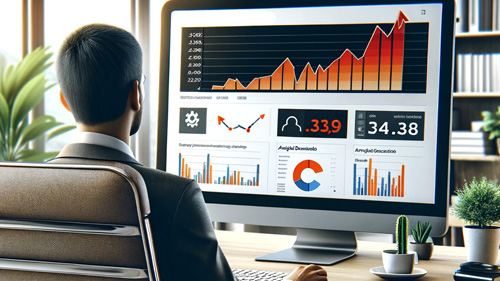On-Page SEO Techniques: Advanced Strategies to Boost Your Search Rankings
Tuesday, July 1st, 2025

Boosting your website’s visibility can feel like navigating a maze, but with the right on-page SEO techniques, you can effortlessly climb the search rankings. Whether you’re a blogger, entrepreneur, or creative spirit, mastering these advanced strategies will not only enhance your online presence but also drive significant website traffic to your content. Let’s dive into some effective methods tailored just for you!
Optimize Your Title Tags for Maximum Impact
Your title tag is the first thing both search engines and visitors see. Crafting compelling and keyword-rich titles can significantly improve your click-through rates. Make sure your primary keyword appears near the beginning of the title, and keep it under 60 characters to prevent it from being cut off in search results. A well-optimized title not only attracts more clicks but also signals to search engines what your page is about, helping boost your website traffic.
Enhance Meta Descriptions to Capture Attention
Meta descriptions may not directly influence rankings, but they play a crucial role in enticing users to click on your link. Write clear, concise, and engaging descriptions that include your target keywords. Aim for around 150-160 characters, ensuring they provide a compelling reason for users to visit your site. A captivating meta description can increase your website traffic by improving your page’s attractiveness in search results.
Utilize Header Tags Effectively
Header tags (H1, H2, H3, etc.) structure your content, making it easier for both readers and search engines to understand. Use H1 tags for your main title and H2 tags for subheadings. Incorporate relevant keywords naturally within these headers to enhance SEO. Proper use of header tags not only improves readability for skimmers but also boosts your search rankings, driving more website traffic your way.
Optimize Images for Faster Loading and SEO
Images are essential for creating visually appealing content, especially on platforms like Pinterest. Ensure your images are optimized by compressing them to reduce file size without sacrificing quality. Use descriptive file names and include alt text with relevant keywords to improve search engine understanding. Faster loading images enhance user experience, which can lead to higher website traffic and better search rankings.
Improve Internal Linking Structure
Internal links help search engines crawl your website more effectively and keep visitors engaged longer. Link to relevant pages within your site to create a cohesive network of content. This not only helps distribute page authority but also guides users to explore more of your content, increasing your website traffic. A strategic internal linking structure is a key component of advanced on-page SEO techniques.
Create High-Quality, Engaging Content
Content is king in the world of SEO. Focus on creating high-quality, informative, and engaging content that addresses the needs and interests of your audience. Use a mix of text, images, and videos to keep your readers hooked. Regularly updating your content ensures it remains relevant, which can improve your search rankings and attract more website traffic over time.
Implement Mobile-Friendly Design
With a significant portion of users accessing websites via mobile devices, having a mobile-friendly design is crucial. Ensure your site is responsive, with easy navigation and fast loading times on all devices. Google prioritizes mobile-friendly websites in its search results, so optimizing for mobile can directly boost your search rankings and increase website traffic from mobile users.
Leverage Schema Markup for Enhanced Visibility
Schema markup is a form of structured data that helps search engines understand your content better. By adding schema to your pages, you can enhance your search listings with rich snippets, such as star ratings, images, and other details. This increased visibility can make your links stand out, leading to higher click-through rates and more website traffic.

Optimize URL Structures for Clarity and SEO
Clean and descriptive URLs are not only user-friendly but also favored by search engines. Use short, meaningful URLs that include your primary keyword. Avoid using complex strings of numbers or irrelevant characters. A well-structured URL helps search engines index your pages more effectively and makes it easier for users to understand what your page is about, thereby increasing website traffic.
Focus on User Experience (UX)
User experience is a critical factor in on-page SEO. Ensure your website is easy to navigate, with a clear layout and intuitive design. Fast loading times, readable fonts, and accessible menus contribute to a positive UX. When users have a great experience on your site, they’re more likely to stay longer, engage with your content, and return in the future, all of which can boost your website traffic.
Utilize Keyword Placement Strategically
Effective keyword placement is essential for SEO success. Integrate your primary and secondary keywords naturally throughout your content, including in the first 100 words, headers, and image alt texts. Avoid keyword stuffing, which can harm your rankings. Strategic keyword placement ensures that search engines understand the relevance of your content, helping to improve your search rankings and drive more website traffic.
Harness the power of buying web traffic and watch your analytics climb.
Monitor and Analyze Your SEO Performance
Regularly tracking your SEO performance is crucial for ongoing success. Use tools like Google Analytics and Google Search Console to monitor your website traffic, keyword rankings, and user behavior. Analyzing this data helps you identify what’s working and what needs improvement. By continuously refining your on-page SEO strategies based on performance insights, you can maintain and enhance your search rankings over time.

Boosting your search rankings with advanced on-page SEO techniques is entirely achievable with the right strategies. By optimizing title tags, enhancing meta descriptions, structuring content with header tags, and focusing on user experience, you can significantly increase your website traffic. Stay consistent with high-quality content and regular performance analysis to ensure long-term success in the ever-evolving digital landscape.
Filed under: Tips & Tricks
Tags: website traffic
Exclusive Offer!
1,500,000 Points for $110 $68. If you're running low on points — don't miss out
limited time